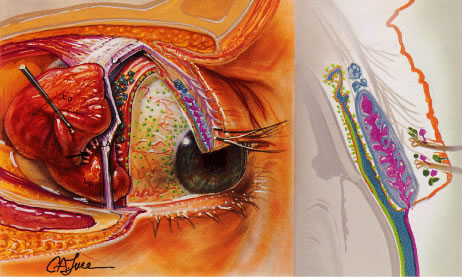

|
| Fig. 24. The basic and reflex secretors of the lacrimal system. The first set of basic secretors includes the conjunctival, tarsal, and limbal mucin-secreting goblet cells, which produce a mucoprotein layer covering the corneal epithelium (green). This is the inner layer of the precorneal tear film. The set of basic secretors consists of the accessory lacrimal exocrine glands of Krause and Wolfring in the subconjunctival tissue (blue). They produce an intermediate aqueous layer of the precorneal tear film. The third group of basic secretors is the oil producing meibomian glands and the palpebral glands of Zeis and Moll (pink), which produce the outermost layer of the tear film. The reflex stimulated lacrimal gland is divided into two portions by the lateral horn of the levator palpebrae superioris (LA). The orbital lobe of the gland (Lo) is larger than the palpebral portion (Lp). The superior surface of the gland is connected to the frontal bone by weak trabeculae. The tear ducts (arrow) from the orbital portion traverse the palpebral portion, which empties its contents into 6 to 12 tear ductules onto the superior lateral conjunctival fornix. Removal of the palpebral portion will, thus, block orbital lobe secretion. (From Zide BM, Jelkes GW. Surgical Anatomy of the Orbit. New York: Raven Press, 1985.) |